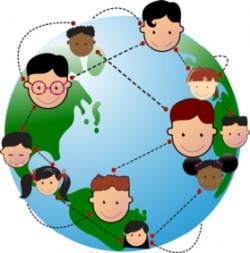What is Visual Literacy?
"While reading and writing will most likely remain at the heart of standard literacy education, educators should reconsider what it means to be literate in the technological age"
(Riesland, 2005)
Although Wikipedia is not a credible resource, it offered a simple definition of visual literacy. It stated that:
Visual literacy is the ability to interpret, negotiate, and make meaning from information presented in the form of an image. Visual literacy is based on the idea that pictures can be “read” and that meaning can be communicated through a process of reading.
Informational text explains ideas, gives directions or shows how to do something.
Visual literacy in education develops a student's visual literacy - their ability to comprehend, make meaning of, and communicate through visual means, usually in the form of images or multimedia.
Visual literacy is the ability to interpret, negotiate, and make meaning from information presented in the form of an image. Visual literacy is based on the idea that pictures can be “read” and that meaning can be communicated through a process of reading.
Informational text explains ideas, gives directions or shows how to do something.
Visual literacy in education develops a student's visual literacy - their ability to comprehend, make meaning of, and communicate through visual means, usually in the form of images or multimedia.
(Wikipedia, 2010)
• Visual literacy is a non literary text in other words it is a text used for the purpose to inform.
• Commute messages to decode them and create meaning.
• It iswhat is seen with the eye and what is seen with the mind.
• It is the ability to decode images, the knack to analyse the influences of the image and
make meaning of its purpose.
• Visual literacy is everywhere around us. It is pictures, photos, signs, maps, symbols, logos,
sms txt, sign language (Auslan) or body language (smile, frown), use of colours, and use of
headings/titles, graphs, charts, rosters etc.
• It is not confined to a particular curriculum area.
• Visual literacy clearly relates to perception and the ability to make meaning of visual
language.
• Visual language consists of combination of words and images and shapes that operate
together to convey meaning that may be sophisticated and abstract.
• Reconstruct past visual experiences with incoming visual messages to obtain meaning.
• Critically reading or viewing images as the language of messages.
• Makes its meaning with images or with patterns and sequences.
• Does not have to be without words.
• Best used in conjunction with text to support the written information.
• Commute messages to decode them and create meaning.
• It iswhat is seen with the eye and what is seen with the mind.
• It is the ability to decode images, the knack to analyse the influences of the image and
make meaning of its purpose.
• Visual literacy is everywhere around us. It is pictures, photos, signs, maps, symbols, logos,
sms txt, sign language (Auslan) or body language (smile, frown), use of colours, and use of
headings/titles, graphs, charts, rosters etc.
• It is not confined to a particular curriculum area.
• Visual literacy clearly relates to perception and the ability to make meaning of visual
language.
• Visual language consists of combination of words and images and shapes that operate
together to convey meaning that may be sophisticated and abstract.
• Reconstruct past visual experiences with incoming visual messages to obtain meaning.
• Critically reading or viewing images as the language of messages.
• Makes its meaning with images or with patterns and sequences.
• Does not have to be without words.
• Best used in conjunction with text to support the written information.
(Stokes, 2002)
"Pedagogy of Multiliteracies" a definition of literacy that includes the "understanding and competent control of representational formats that are becoming increasingly significant in the overall communications environment, such as visual images and their relationship to the written word-- for instance, visual design in desktop publishing or the interface of visual and linguistic meaning in multimedia."
(Riesland, 2005)


